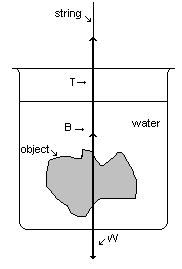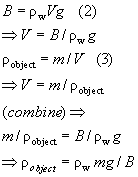LAB - Buoyancy
We actually know specifically what the buoyant force is: the buoyant force on a
submerged body must be equal to the weight of the fluid displaced by the submerged
body. We can use this property of the buoyant force to measure the density of an object by
submerging it in a fluid.
Density is mass over volume: r = m/V.
Finding the density of an object can help us to identify the object because
no matter what shape it is, or what it looks like, a given material has a
constant density. We would like you to validate this procedure on a specimen of
known density, and then identify three objects by calculating their densities. You should measure the density of each,
and then look on a table of densities to see if you can identify what the material is.
Experiment:
Archimedes’ principle states that a body immersed in a fluid experiences an upward
force due to the surrounding fluid and that this force is equal to the weight of the fluid
displaced by the body. We can make use of this principle to determine the volume or the
density of various substances.

Consider a body immersed in water, as shown above. The density of the body is greater than
that of water, and so to keep the object from sinking, we support it with a string. The
tension T in the string plus the buoyant force B of the surrounding water is just
sufficient to balance the weight W of the object.
That is,
W = T + B. (1)
We can use this equation to find the buoyant force by weighing the body in water to
find T, provided we suspend the body from the weighing scales using the string. If we
measure the weight out of the water and then the weight in the water, we can determine the
buoyant force from this equation. (Apply equation 1 to the two different situations -
out of the water, the buoyant force is zero.)
The buoyant force is the weight of the displaced water. The volume of displaced water
is, of course, the same as that of the body. Since the buoyant force is the weight of the
water displaced by the object, then the buoyant force is the density of the water
multiplied by the volume multiplied by g:
 . (2)
. (2)
By definition, the density of water is exactly 1000 kg/m3, so using this
equation, we can find the volume of the body using the buoyant force determined as in
equation 1. If we know the volume and the real weight W, then we can determine the density
of the object
 . (3)
. (3)
Apparatus
Windows PC with Logger Pro
LabPro Interface
Stand and small clamp
Dual range force sensor (set to 10N) with rod
Beaker with water
One aluminum cube, one unknown cube and one rock-mass
Procedure and Analysis:
- Make sure everything is plugged in, force sensor is plugged into the
interface, and the interface is on. Start LoggerPro. Okay any windows that
pop up (unless they are errors), and give it a moment to recognize the force
sensor. If the force sensor is plugged in, LoggerPro should recognize it, and you
should be able to skip steps 2, 3. If the graph, table, and meter for force do not
show up, you need to do step 2.
- Once you have opened LoggerPro, click File, Open, Probes
& Sensors, Force Sensors, Dual Range Force, and open
"10N Dual Range.mbl".
- On the menu bar at the top of the LoggerPro screen, select Insert, then
slide down to Insert Meter, and then slide over to Digital Meter. You
should get a pop up that is reading the force pulling down on the force sensor
in Newtons.
- The switch on the force sensor should be set to 10
N. The small rod that comes
with the force sensor should be clamped to the stand and clamped through the
hole that goes through the middle of the force sensor itself, so that the
hook on the force sensor hangs downward.
- Calibration of the Force Sensor:
- Click Experiment tab at top, and choose Zero to indicate the sensor
should read 0.
- Click again on the Experiment tab on the menu bar, and choose Calibrate
and choose the Dual Range Force sensor.
- Select Live Calibration.
- Click on the Calibrate Now button.
- The sensor wants a known force to be applied: start by hanging a mass
hanger which has a mass of 50 gm, and type the weight (in Newtons,
not the mass) of the
hanger in the first calibration box. Click on the Keep button.
- The sensor needs a second, different force to be applied. Add
500 gm to the mass hanger and hang it on the
force sensor. Type the value of the total weight (in
Newtons, not the mass) in the
box and click Keep.
- Click DONE or OK until you are out.
- Check to see that you are reading close to the weight you entered for
the 550 grams (the mass hanger and 500 gm mass should still be on the
force sensor). Then take the 500 gm mass off the hanger and see if you are close
to the weight you entered for the 50 gm hanger. Finally take the
hanger off and verify that you get
close to 0 (you should not be off by more than about 0.01 Newtons for any
of these three measurements if your sensor calibrated properly).
- Now for the experiment: Do the known, aluminum, first. For each of the
three objects, suspend the mass from the force sensor and wait for the
meter on the computer to read a mostly constant force. If it doesn't
settle enough, average the range of numbers. Then slide the beaker
underneath the force sensor and submerge the object completely in the
water. Take a second reading from the computer screen. You will
end up with two readings for each object, one in the air and one in the
water.
- Note that your weight measurement in air, is the W in equation (1) and
the weight measurement in water is the T in equation (1). Therefore
the difference of the two, is the buoyant force B and is defined by equation
(2). Having calculated B from W-T, we can now use equation (2) to find
the volume V of the object. Using your measurements, you can then determine
the density of the abject.
- Determine the density for the known material and compare your calculated
value to its listed density (see menu at left). Be sure that your calculated density is
close to the listed density to validate your procedure.
- Now, using the densities you calculated for the two unknown specimens, determine the material each specimen is made of by comparing your density to a chart of
densities. It is fair to use observations other than simply density.
- If this is a formal lab: For ONE of your measurements, estimate your precision from the precision
of your force sensor (see below).
Error Analysis:
Notice that if we solve equations 2 and 3 together, we get

recall that mg is the weight of the object, W. The error in the density is going to be
due to the error in W and the error in B (each due to the imprecision of the scale,
which you are going to have to estimate.)
For algebra-based physics (for calc-based, skip forward): recall that the error in density due to the error in weight is
 ,
,
and the error due to the error in the buoyant force is
 .
.
For calc-based physics, you need to find the error in density due to
the error in W and the error in density due to the error in B using partial
derivatives.
You need to find the error in the density due to W, and the error due to B, and find
the square-root of the sum of the squares (as we have done in the past with error
propagation.)
Extra Credit:
1. Does the real world aspect that the string has weight introduce an error
into our estimation of the density? Please back up your answer with an
equation to show why you believe as you do.
2. Is the Energizer Bunny male or female?

Write-Up
-
If this is a formal lab (as indicated on the lab syllabus), you have been
instructed as to whether this is an individual or group write-up, or an oral
presentation. If it is a write-up, each person
must submit the lab electronically as a word-processed document in Moodle
before the next lab meeting. If it is a group write-up, you should all
be submitting the same document. For written formal labs, remember to check the "write-up hints" page to be sure
everything is included and check your write-up against the grading rubric.
- If this is an informal lab, work on the results together in your groups,
and be sure to have your complete informal lab in your lab notebook and
checked by the instructor before
you leave.
- Remember to read the next lab and do the pre-lab before you come to lab
next week! You may work on the pre-lab with others, but each person must
submit her or his own work.
Department
of Physics



![]() . (2)
. (2)![]() . (3)
. (3)
![]() ,
, ![]() .
.